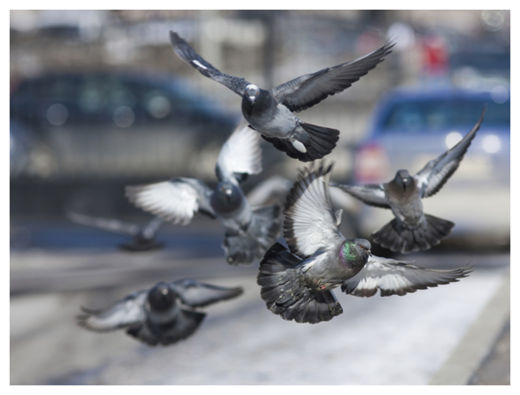
© iStockphoto/ThinkstockFollow the leader. Pigeons leave behind their social structure in flight.
When a flock of birds changes direction on a dime, it's easy to imagine that the group is controlled by a single, collective mind. But in reality, the individual matters. That's the message of new research on group navigation in homing pigeons. The study used computer tracking to reveal a complex hierarchy, where even birds with a low social rank on the ground may be trusted leaders in the air.
In research on animal social dynamics, large mammals such as wolves and gorillas have received a lot of attention, because their groups' smaller numbers make them easier to study, says Andrew King, a behavioral ecologist at Swansea University in the United Kingdom who was not involved in the study. But when hundreds or thousands of creatures synchronize their movements, the decision-making process is harder to sort out. King says that these big groups have traditionally been viewed as hoards of anonymous agents in a democracy. "Five or so years ago, papers were saying that you should be finding consensus decisions where everybody has an equal say."
And yet elaborate synchronized movements arise from individuals with various abilities and social roles. Zoologist Dora Biro of the University of Oxford in the United Kingdom wanted to investigate how a flock of pigeons manages to stay organized as it navigates the skies. "Different individuals within these flocks might have different ideas about where they want to go," she says "but at the same time, they want to maintain a kind of cohesive flock, because there's safety in numbers." Computerized tracking methods make this type of research possible. Remote visual sensors and GPS units on the birds can keep tabs on every bird at every moment, and complex data analysis can tease out meaningful social patterns.
Biro teamed up with a group of statistical physicists at Eötvös Loránd University and the Hungarian Academy of Sciences in Budapest to search for a leadership structure in flight and to find how it relates to the overall social structure of the flock. The team followed a single flock of pigeons in two different situations: competitive feeding on the ground and navigating in the air. This cross-context approach is "a really important contribution to the field," says behavioral ecologist Darren Croft of the University of Exeter in the United Kingdom who was not involved in the work. "We knew about dominance and we knew about flight, but no one has put those two things together."
The team first identified the birds more likely to win out in confrontations and gain access to food. In the lab, each bird wore a unique three-colored barcode on its back, and a camera attached to the ceiling tracked the animals as they clambered around a cup of grain. A program evaluated birds in pairs and picked the dominant one based on how quickly he or she approached or avoided the other birds and who ended up reaching the snack. Dominant birds tended to be both larger and more aggressive.
When the same birds took to the air in a flock of 30, each wore a tiny GPS unit on its back, which took 10 position readings every second. Every time the flock made a decision - to shift directions, for example - the researchers compared the movement of each bird to the others to find who shifted first, and by how much time. "You can draw an arrow between Bird A and Bird B to show which one tends to lead the other," Biro says, "and you can draw up, basically, a network of these interactions to cover the entire flock."
The network that emerged was far from a perfect democracy. The birds formed a stable hierarchy, where certain individuals made decisions and others waited for cues. A leading bird might swerve first, prompting a neighbor to adopt the same direction. (Some in-between birds were both trusted leaders and devoted followers.) What's more,
the leaders in flight weren't the dominant birds on the ground, meaning that the pigeons ignore their land-based social structure while in the air, the team reports online today in the
Proceedings of the National Academy of Sciences.
An individual's leadership role in the air remained constant, regardless of the composition of its flock, suggesting that certain qualities inspire the trust and obedience of others. But exactly what makes a natural leader isn't yet clear. Biro thinks there are likely multiple factors at play, from better navigational skills and more decisive movements to motivational factors, such as eagerness to get back to a nest. Croft points out that the physical demands of flight make it more difficult to display aggression and that when birds collectively decide how to move on the ground, they might stick to their dominance structure.
The same approach could be used to find out how other species, from insects to primates, choose leaders to form stable and successful groups, Biro says. "We know that who you're going to elect as your next president or your prime minister is going to make a huge difference for how happy people will be in the country." The team now hopes to sort out which traits are most valuable for leadership in the animal world.
Watch Video Here
Reader Comments
to our Newsletter